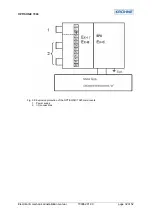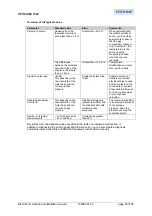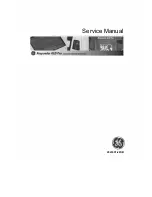
OPTISONIC 7060
Electrical & mechanical installation manual 730962.31.00 page 44 of 52
6 Maintenance
6.1 General
The OPTISONIC 7060 does not contain any components that move mechanically. Meter body
and ultrasonic transducers are the only components that come into contact with the
gaseous media. Titanium and high-quality stainless steel ensure that these components are
resistant to corrosion, provided that the device is implemented in accordance with the
relevant specifications. This means that the OPTISONIC 7060 is a low-maintenance system.
Maintenance essentially involves routine checks to determine the plausibility of the
measured and diagnosis values calculated by the system.
It is recommended to record a diagnosis and status log on a regular basis (see software
manual) and compare these values with the initial situation when the system was
commissioned. The operating conditions (gas composition, pressure, temperature, flow
velocity) of the individual logs should be comparable or documented separately and taken
into account when the comparison is evaluated.
6.2 Routine
checks
You can check the front panel of the OPTISONIC 7060 to ensure that the system is
functioning
properly
(see
Section
4.3
).
The routine checks relate to the following values (see also the table below and Section 6).
Velocity of sound
The velocity of sound measured is usually highly stable. Sudden changes in the measured
value can indicate signal detection problems, which can affect propagation time
measurements, or changes in the gas composition. A theoretical velocity of sound value can
be calculated by analysing the gas or recording the pressure and temperature during log
measurement. Implausible measurements can then be indicated by comparing theoretical
and measured velocity of sound values and identifying any marked discrepancies. The
velocity of sound values in the paths should also be approximately equal.
Number of rejected measurements
The number of rejected measurement (% inaccurate measurement) for the measuring
path(s) should be as close to 0 % as possible, although this largely depends on the flow
velocity. With high flow velocities, the figure can be as high as 50% without affecting
accuracy. Marked discrepancies in the values under similar conditions (pressure,
temperature, gas flow rate, gas composition) indicate that changes have been made to the
device or plant (e.g. malfunctions caused by a valve that is not fully open).
Receiving
sensitivity
The receiving sensitivity set by the device largely depends on the process pressure. Under
normal conditions, this value is highly stable. The difference between the ultrasonic
transducers for a measuring path is small, although it can increase with greater velocities.
Significant fluctuations in the receiving sensitivity indicate a low-quality receiving signal. A
significant increase under similar process conditions is normally caused by contamination
on the ultrasonic transducers (for instructions on cleaning them, see the service manual).
Signal-to-noise ratio
These values are typical for the plant and do not change, providing the conditions remain
the same. A reduction in the signal-to-noise ratio with similar reception sensitivity indicates
sources of acoustic interference (e.g. pressure regulator) near the measuring location.









































